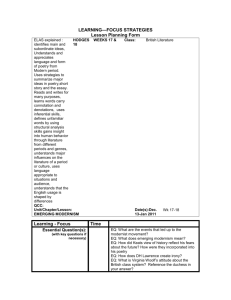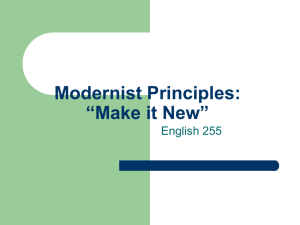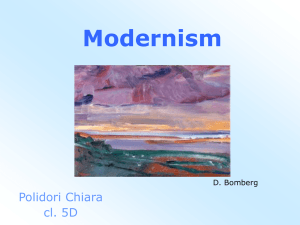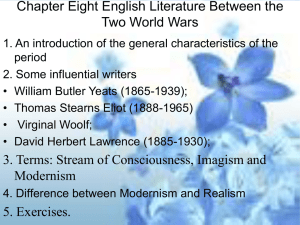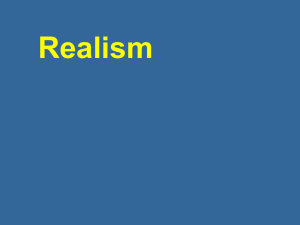The Psychological Novel
advertisement
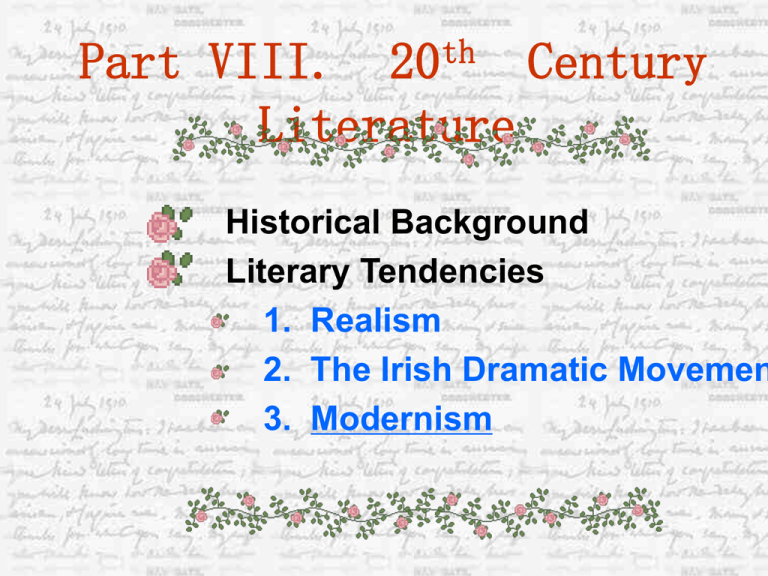
th 20 Part VIII. Century Literature Historical Background Literary Tendencies 1. Realism 2. The Irish Dramatic Movemen 3. Modernism Realism • • • • • Joseph Conrad Henry James Katherine Mansfield Thomas Hardy Galsworthy John Galsworthy A Survey of Modern and Contempotary British Literature Modern British Literature (1914-1945) Social Background Major Writers Novelists Poets Dramatists Historical Background • Natural and social sciences emormously advanced • Capitalism came into its monopoly stage • Gap between the rich and the poor was further deepened • World Wars I and II • Economic Depression beginning in 1929 Philosophical Backgrounds • Karl Marx: scientific socialism • Darwin’s theory of evolution: “survival of the fittest” • B. Sigmund Freud’s psychoanalysis -psychological determinism -man behavior from forces INSIDE the self -self-analysis • F. Nietzsche -God is Dead -economic and psychological determinism -no divine patterns, search for meaning Modernism 1. It originated from skepticism and disillusion of Capitalism 2. The French symbolism announced modernism 3. It takes the irrational philosophy and the theory of psychoanalysis as its theoretical base. The major themes are the distorted, alienated and ill relationships. 4. The literature in this period is defined by its rejection of the literary conventions of the nineteenth century and by its opposition to conventional morality, taste, traditions, and economic values. Difference Between Modernism and Realism Modernism is a reaction against realism in many aspects: • 1. Modernism rejects rationalism, which is the theoretical base of Realism • 2. Modernism rejects the source of Realism, i.e. the external, objective, material world • 3. Moernism rejects almost all the traditional elements in literature The Novels • End of the 1910s-the 1920s • The 1930s • The 1940s End of the 1910s-the 1920s • Relatively freer form • Break of reticence • New voyage into consciousness Which was a reaction »to the fragmentation of culture, »to a catastrophic history, »to the pervasive sense of psychic crisis, »to modern violence and dislocation. directions : Realistic modern writers: Ford Madox Ford, W. Somerset Maugham, E. M. Foster The Psychological Novel Modernist writers: James Joyce, Virginia Woolf F. M. Ford (1873-1939) • The Good Soldier A Tale of Passion His literary activities built an experimental bridge between the old writers of the 1890s and the younger innovators. His literary theory: Impressionism • “we accepted the name of impressionists because we saw that life did not narrate but made impressions on our brains.” “We in turn, if we wished to produce an effect of life, must not narrate but render impressions.” E. M. Forster (1879-1970) • A novelist who tried to “connect” people of different backgrounds and different cultures. • • • • • Where Angels Fear to Tread (1905) A Room with a View (1908) Howards End (1910) A Passage to India (1924) Style: realism combined with symbolism (He liked to use images and symbols to express his concerns for the social morals and humane values.) satire and humor Symbolism • The symbolists emphasize the suggestiveness of poetic language, but though this emphasis on suggestiveness makes much of the poetry obscure, their care for the organization and operation of language keeps it from vagueness. A critical work: Aspects of the Novel (1927): “round” and “flat” characters The Psychological Novel • While modernist poetry arose as a break with 19th –century Romanticism, modernist fiction represented a trend drifting away from the tradition of 19thcentury realism. Modernist fiction put emphasis on the description of the characters’s psychological activities, and so has sometimes been called modern psychological fiction. D. H. Lawrence James Joyce (1882-1941) • One of the most innovative novelists of the 20th century and one of the great masters of “the stream of consciousness”. Stream of Consciousness • A phrase coined by William James in his Principle of Psychology(1890) to describe the flow of thoughts of waking mind, and it was first applied to literature in 1918. Since then it has been used to describe the narrative technique which attempts to render the consciousness of a character by representing as directly as possible the flow of feelings, thoughts and impressions without resorting to objective description or conventional dialogue. The term “interior monologue” is also sometimes used. • A Portrait of the Artist as a Young Man (1916) • Ulysses (1922) • Dubliners (1914) • Finnegan’s Wake (1939) Ulysses • Life experiences of 3 main characters on a single day (June 16, 1904) in Dublin. The principal characters are Leopold Bloom, an advertisement canvasser, his wife Molly and the wanderings of Stephen and Bloom through Dublin and their eventual meeting. Ulysses • Artistic features: 1. Parallel to Homer’s “Odessey” in character, structure and language 2. Striking realistic skill: vitality of “felt life” and innovative use of “interior monologue” 3. Joyce’s stream of consciousness Joyce’s contributions • His novels changed the conventional conception of fiction in the sense that there were no longer, in the conventional sense, the characters, actions and events in the novel. Instead there was just a stream of consciousness flowing through the whole novel. Virginia Woolf One of the most innovative novelists of the 20th century and one of the great masters of “the stream of consciousness”. • A woman must have money and a room of her own if she is to write fiction. • Unlike Joyce, whose stream of consciousness is both aesthetic (Stephen’s reflections) and subterranean (Molly’s soliloquy), her stream of consciousness is flowing, poetic, feminine and above all, painting-like and aesthetic. Bloomsbury Group • An exclusive intellectual circle that centered on the house of the publisher, Leonard Woolf, and his wife, the novelist, Virginia Woolf, in the district of London. It flourished notably in the 1920s. • avant-garde The 1930s More practically-oriented Communist revolutions Advent of Fascism Rise of Nazism Satirists: Evelyn Waugh, Aldous Huxley, George Orwell, Jean Rhys Evelyn Waugh (1903-1966) • A leading satirical novelist in the 1930s. I have seen fear in a handful of dust.---T. S. Eliot About Evelyn Waugh’s Writing • His works are rich in colloquialisms, yet full of characters who are characterless, deliberately lacking of psychological depth, and who were swept along by circumstances over which they had no control. So we feel, behind the farce and hopelessness the solidity of a permanent tragedy. Aldous Huxley • A satirist in the 1930s. A fable about a future society 旋律与对位( 1928 ) George Orwell (1903-1950) • A political satirist. • His best-known novel, a fable satirizing Russia and setting Stalinist totalitarianism in a farmyard, which make Orwell world famous. “all animals are equal but some animals are more equal than others” (1945) • A political satire, also a despondent forecast of what would happen when totalitarianism was able to take over not only the body but the soul. The 1940s • More religiously-oriented (disillusionment and dissatisfaction with the drift of material civilization) • Graham Greene Graham Greene (1904-1991) • A leading exponent in English of the existentialistpsychological fiction which has dominated European literature since the 1940s. Existentialism • A modern school of philosophy which had a great influence on European literature since World War II. It was generally associated with German philosopher Hedegger (1889-1976) and French philosopher Sarte. It emphasizes the uniqueness and isolation of the individual experience in a hostile or indifferent universe, regards human existence as unexplainable, and stresses freedom of choice and responsibility for the consequences of one's acts. • 在格林的作品中,读者看到的并不是艾略 特(T.S.Eliot)诗作中那种一片干旱的荒原, 而是一个被评论家称作“格林之原” (Greeneland) 的世界,一个由多种信仰、 多种性格、多种经历的人组成的错综复杂、 扑朔迷离的精神世界。正是由于格林在他 的作品中创造了这样一个复杂的、常常是 自相矛盾的、但更接近现实的世界,才使 他成为二十世纪最受读者欢迎,同时在评 Poets: T. S. Eliot A pioneer of the Modernist poetry and one of the greatest poets in the world. When the evening is spread out against the sky Like a patient etherised upon a table; I have measured out my life with coffee spoons To spit out all the butt-ends of my days and ways? Streets that follow like a tedious argument Of insidious intent To lead you to an overwhelming question. I grow old… I grow old… I shall wear The bottoms of my trousers rolled. W. H. Auden (1907-1973) • The most important poet immediately after T. S. Eliot. Contemporary British Literature • From 1945-the 1960s • From the 1970s to the End of the Century From 1945 - the 1960s • Political situations:Cold War after World War 2; economic difficulties • Ideological and intellectual spirit: 1. A moral concern:the men of letters showed the absurdity and emptiness of existence, the human anguish and despair and the inner vacancy of self on the one hand and showed a serious concern for the future and affirmed the need for a moral regeneration on the other. 2. The cultural revolution:Deconstruction Novel • The 1950s: a period of “Angry Young Men”, following the 19th-century realistic tradition and focusing on the post-war reality of the English society. • The 1960s: rising of self-consciousness and new experimental novels- “metafiction”. Kingsley Amis (1922-1995) • The most important representative of the “Angry Young Men”. • Lucky Jim Angry Young Men • A term which is loosely applied to a number of British novelists and dramatists of the 1950s including John Wain, Kinsley Amis, J. Osborne, John Braine, Sillitoe and C. Wilson. They created a series of anti-heroes educated out of the working calss and expressed a sense of dissatisfaction and revolt against established social morals and described various forms of social alienation. They followed the 19th century realistic traditions in their writing techniques and were against the modernist experimentalists of the 1920s and 1930s. This literary phenomenon disappeared in the 1960s. Anti-hero • The term antihero has a variety of definitions, ranging from unconventional heroes, a protagonist lacking heroic qualities or even one possessing traits antithetical to the traditional hero. William Golding (1911-1993) • A Nobel Prize winner who created modern myth. “The theme is an attempt to trace the defects of society back to the defects of human nature” Golding often presents isolated individuals or small groups in extreme situations dealing with man in his basic condition, creating a quality of a fable. He is concerned with the fundamental questions of good and evil: deep and timeless idea, universal and diverse modern myth. Iris Murdoch (1919-1999) • Her contributions: her characterizationthose memorable characters do have a realistic psychological and philosophical basis. • Under the Net (1954) • The Bell (1958) • The Sea, the Sea (1978) Muriel Spark (1918-2006) Doris Lessing (1919-1999) • One of the most famous experimentalist writers of the 1960s. • Her style: traditional narrative language, multi-points of view • Her significance: bold experiment in the form of writing, deep insight into the contemporary social affairs. The Golden Notebook (1962) • It is considered her masterpiece and is admired for its formal and thematic complexity and it is also considered a milestone in Feminist literature. • It is a “meta-fiction”, a story within a story. Metafiction • It is applied to fictional writing which question the relationship between reality and fiction through deliberately and selfconsciously drawing attention to its own status as a linguistic construct.John Fowles’s “The French Lieutenant’s Woman”. John Fowles (1926-2005) • A master chronicler of the second half of the 20th century and also a great experimentalist writer. The French Lieutenant’s Woman (1969) Poetry • The 1950s: heyday of the so-called Movement. Revival of the English tradition, but concerned with the contemporary human experience: life’s emptiness, death, transience. Philip Larkin is the most important Movement poet. • The 1960s: mixture of traditional style with Modernist and Post-modernist styles of the US and of Europe. Ted Hughes, Geoffrey Hill, etc. Philip Larkin Ted Hughes, Geoffrey Hill • Poets of the 1960s against Movement • Ted Hughes: original in the sense that he celebrates the instinctual and the brutal, depicted cataclysmic or desolate scenery and gives us a cartoonery of human struggle and destiny though the images of the animal world. Drama • 1. the New Drama revolution began in Britain when John Osborne’s play Look Back in Anger opened in 1956. It is a movement wherein the genteel comedy of manners that dominated the stage for decades would be replaced by a radical social consciousness that challenges both the previous aesthetic preferences and social order that supports the aesthetic. • 2. An allied revolutionary movement occurred slightly before. In 1955, Samuel Beckett’s Waiting for Godot found its way to the London stage. If social disruption was the key to kitchen sink realism, philosophical disruptions were key to Beckett’s theatre of the absurd.It was later developed by Harold Pinter and Joe Ortin. John Osborne (1929-1994) • His work marked the turning point of the Modern stage. Arnold Wesker (1932-) • A great playwright of the “Kitchen sink realism” Chicken Soup with Barley Samuel Beckett (1906-1989) • A great playwright who revolutionized English plays. Waiting for Godot Theatre of the Absurd • A name given by the critic Martin Esslin to describe the work of a number of dramatists. These and other such authors did not belong to any “school” but their plays often had in common the sense that human existence was without meaning. The idea was reflected in the form as well as the content of the plays, by the rejection of logical constrution, and the creation of meaningless speeches and silences. Harold Pinter (1930-) • One of the most important and influential playwrights of the 20th century. From the 1970s to the End of the Century Martin Amis(1949-) • Money: A Suicide Note • Time’s Arrow Seamus Heaney (1939--) • He was rightly awarded the Nobel Prize in 1995 “for works of lyrical beauty and ethical depth which exalt everyday miracles and the living past”.
